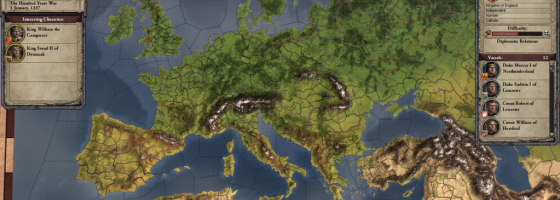We’ve talked about plenty of industry trends in the past, from digital distribution to game sales and so much more. For today, I want to touch on something that is really affecting how games are being designed, sold and consumed by the audience, and that is the act of long-term game development and how it’s changing the basic foundation of game design.
One and Done:
Before the rise of digital distribution, video games were designed with a one and done mindset, where the developer/publisher were designing a game built around one play or one design period and that’s it. After the game was beaten and the player reached the literal end, it was sold, traded in or shelved until further notice. This also was the case for many multiplayer titles, including mega games like Starcraft or Unreal Tournament. Even though these games were popular, they were designed around a set amount of work and post release support by the developer.
If the game died, then it would have hopefully made enough money for the developer to break even. If the game thrived, then the developer may work on an expansion or keep the servers running, but that was about it. Because of this focus on one play, developers and publishers were very cautious about bugs and any issues with their title; as they wanted to put their best and only foot forward for the consumer.

Blizzard’s change in game development style has greatly extended the lifespans of Diablo 3 and Starcraft 2, with continued support and refinement of the designs
This was the time where modders began to earn notoriety as the means to prolong a game’s lifespan thanks to more content. Everything from new skins, game modes, full on conversions and more; we saw a huge variety in terms of quality and content from the modding community, including the likes of They Hunger and Team Fortress for Half-Life.
As digital distribution allowed developers to easily and quickly keep games up to date and provide an instant connection to their fan base, a certain game that I’m sure no one has ever played decided to change things.
The Team Fortress Transition:
Team Fortress 2 is a game of many firsts, which we could spend entire posts talking about. For today however, we’re going to focus on the post release support of the game. When Team Fortress 2 was released, the game was developed just like any other game at the time; there was great content to the game, but it was still a limited experience. If Valve would have kept TF 2 the way it was, they and the audience would have gotten their money’s worth, but they decided to keep growing the game.
TF 2’s long-term support grew tremendously and I’m not going to reiterate it for what must be the dozenth time here, but I want to talk about the impact. By continuing to support the game, Valve made sure that its online community never grew bored with it; making sure that the community continued to grow and there was always someone to play with. Obviously, all the work on the game attracted the press and raised the game’s fame even more.
When TF 2 went F2p and added in monetization, something happened that other developers could not have predicted, the game continued to make money. Previously, the only games that were able to continue earning beyond the initial purchase were MMOs; thanks to monthly subscription fees to keep playing. By continuing to have money come in, this created a positive feedback loop for Valve: The profit from the microtransactions afforded them to keep working on the game which led to more content being produced which gave them more profit and repeat.
Thanks to TF 2, game development has begun shifting away from one and done games and there is a new philosophy with games today.
Long-Term Development:
The goal of popular games today is not just make a lot of money for the first few weeks of sales, but to continue putting out content and earning money for months or even years on end. Instead of a developer having to take another risk on an untested property, they can continue to earn money via a game that they already know is popular and profitable.

Long-term support means continuing to work on a game way beyond its initial release and can mean huge profits for games that continue to grow
This has led to a huge renaissance in terms of strategy games, whose free-form play makes it easy to add new content that integrates into the experience. Paradox Software for example has become one of the biggest supporters of DLC and long-term development.
Instead of having to make one giant game that could take years to add everything in for one purchase, they plan their releases around a base set of content and expanding on that with continued work and DLC. The consumer still gets a great game, but now there is a lot more to like and spend money on.
Call of Duty is another example and perhaps the dream for AAA developers. Every year a new Call of Duty game is released, with continued content and microtransactions for the entire following year. This keeps the player base enjoying the game and earning money for Activision until the next game is released and the process begins again.
Another positive is that it allows developers to mitigate the risk of putting all their eggs in one basket. Instead of dedicating several years to one giant game and hoping that it succeeds, they can release a smaller yet completed title and test the waters; if the game does well, then it can be expanded, if it doesn’t, then the developer can move on to their next idea.
When a game does really well, it could theoretically be supported indefinitely, or until the developers make a sequel. League of Legends shows no signs of stopping and instead of trying to make a second game, Riot Games continues to update the game engine and back end to keep the game working and future-proof it. I’ve talked about Payday 2 a number of times and it is an example of this; with the game’s six months of planned DLC growing to several years of continued support.
Continued support like this is a double edged sword for a lot of people, which takes us to the debate from consumers.
Insert Monetization to Continue:
Long-term game development as we talked about has led to increasing the time and development on a single title, but it obviously increases one other thing: The amount of money spent. To continue growing a game means that different parts of your team will have to keep working on the game: Artists and programmer to add new content, developers to come up with it, server and architecture support teams to make sure that people can connect, and that equals money. More importantly, the more you work on one title, the less you can work on other projects.

Long-term support has also led to increasing uses of DLC and monetization, causing a debate among consumers about the real cost of buying a video game
This causes developers to do one of two things: Increase their staff (and their daily operating cost) to continue working on multiple projects, or go all in with one game.
Long-term game development is like trying to keep a boat with a hole in it afloat, you have to constantly keep it supported or the whole thing sinks. At this point, I’m sure everyone can guess what’s the best way to keep a game supported and funded? Monetize it.
Games that are built around years of development are now including monetization. You no longer spend money on the initial product and be done with it, now you’re continuing to spend money every few weeks or months to keep your game up to date. As we talked about, games these days are being designed around a more compact experience, but with prices still high for AAA games. You’re not just spending $60 on a new game, but easily over $100 when you throw in season passes and DLC content.
Another problem is that games these days are being designed around constant work, which means constant chances for bugs and issues to slip through. Publishers and developers aren’t as careful for their first release anymore; because they can work on day one patches or more support after the game comes out. The other reason is that you can’t be as careful anymore due to the fact that every change to a game can cause problems and unless the game is completely finished, there will always be the chance for a bug to slip through.
The final problem and one that is starting to show itself now, is if a game changes too much from the original purchase. Both Payday 2 and Team Fortress 2 are different games now than they were when people first bought the game. In Payday 2’s case, they recently had a huge consumer backlash after going back on their word two years ago saying that the game would never have micro transactions. Many people feel that they have betrayed and lied to, because they are still holding the developers to the original promise.
As we’ve talked about, games rarely stay the same over the course of development and with games going for long-term development; it’s very possible for a game to no longer be as advertised when it was first purchased. What this means for the future remains to be seen, but as developers go for making their games bigger, this will be something to keep in mind.
Making Good Stuff Better:
To end on a high note, long-term development has more pros to it than cons at this moment. Being able to play a game you love and know that the developers are going to keep working on it to make it bigger and better is a great thing for consumers. And for developers, we already talked about how this can mitigate some of the risks of game development.
We are still in the early periods of long-term design, and as the line between a finished product and a work in progress continues to blur, it’s going to be an interesting next couple of years.


